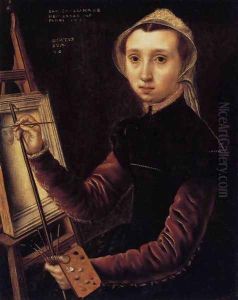Caterina van Hemessen Paintings
Caterina van Hemessen was a significant figure in the Northern Renaissance, particularly renowned for her contributions to Flemish painting. Born in 1528 in Antwerp, then part of the Spanish Netherlands, she emerged from a backdrop of a flourishing art scene, pivotal in shaping her career. Her father, Jan Sanders van Hemessen, was a well-known Mannerist painter who played a crucial role in her artistic development, serving as her mentor and introducing her to the art world. This familial tutelage provided Caterina with a solid foundation in the techniques and themes prevalent in 16th-century Flemish art, notably in religious and portrait painting.
Caterina van Hemessen is best remembered for her detailed and refined portraits, which are among the earliest known works by a female Flemish painter. Her oeuvre is characterized by its intimate portrayal of subjects, often depicted against plain backgrounds that enhance the focus on the sitter's facial expressions and intricate clothing details. One of her most celebrated pieces is a self-portrait dated 1548, where she is depicted seated at an easel, painting. This work is significant not only for its mastery of technique but also because it is considered one of the first known self-portraits by a female artist. Through this painting, van Hemessen subtly asserts her identity and skills as a professional artist, challenging the gender norms of her time.
Throughout her career, Caterina van Hemessen enjoyed the patronage of the Spanish court, which was then ruling over the Netherlands. This association provided her with opportunities to work on commissions for high-profile clients, further establishing her reputation. Despite the recognition she received during her lifetime, her work, like that of many other female artists of the period, was somewhat eclipsed in later centuries by her male contemporaries.
Van Hemessen's marriage in 1554 to Christian de Morien, an organist, marked a turning point in her life. Following her marriage, there are fewer records of her work, suggesting that she may have reduced her artistic output. Nonetheless, her legacy lives on through the small but significant body of work she left behind, which continues to be studied and admired for its contribution to the understanding of 16th-century Flemish art. The exact date of Caterina van Hemessen's death is not known, but records indicate she was alive in 1587. Her life and work remain a testament to the skill and perseverance of women artists in the Renaissance, paving the way for future generations.
